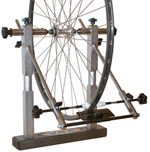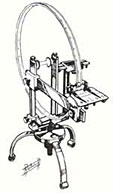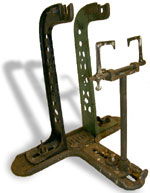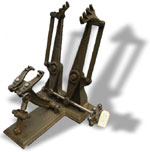
While
you don’t need a truing stand for straightening, fixing or building
wheels (it’s almost as easy to use your bicycle to hold the wheel
while you work), they sure are fun to own and use. And, over the years
there have been many interesting and ingenious designs for truing stands
and the wheelbuilding tools like spoke wrenches, nipple drivers, dishing
tools and tensionometers that are used during wheelbuilding.
This
page showcases some of these fun and handy tools. To start, here are
some pictures of my truing jig, which features a custom base made by
a woodworker friend, a Park TS-2
Truing Stand (note: I bought mine in the late seventies; Park
now calls the stand the TS-2.2) and a dial-indicator
(set up for lateral truing). Don’t want to build your own base?
If you have a bench vise, you can clamp Park’s stand in it, or
go with Park’s Truing
Stand Base.
There
are other makers of truing stands but I have yet to find one that is
as easy to use, reliable and durable as Park’s. I highly recommend
it. Any bicycle shop can order it for you, or you can order it online.
Here’s a link to it on
Amazon.com
Also read
my extensive bicycle wheelbuilding
instructions and tips
& tricks.
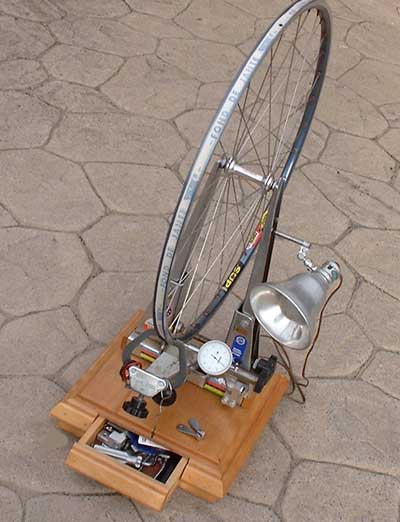
Click
photos below to enlarge
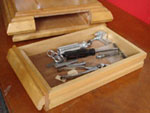
My stand is constructed of birch; roomy drawer is perfect
for spoke wrenches, nipple drivers and more; drawer pull hides
neatly in base trim when closed
|

The drawer slides smoothly on the rails inside; nice side and base
details give the truing stand a proud stature on the workbench |

Wood end caps press into the open ends of Park’s stand to
hide the bolts and provide a finished look; notice the many steps
to the stand's profile |
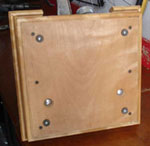
A 30-pound lead weight inside the base ensures no wobbles when truing,
while rubber feet keep it from walking |
Some
other interesting truing stands (hard to find or antique)
|
|
|
|
|
Var’s
Atomic mounts to a workbench and is made of heavy-duty steel
and cast components. Knobs are plastic/nylon |
The
PréciRay
has built-in dial indicators that make truing easy:
"When the wheel is stopped the pointers
indicate magnified three times every radial and axial deviation
so you can find out without trial and error the nipple on which
you have to operate and at the same time the number of turns to
apply in order to bring the rim to the correct position." |
Stands
like this were probably used at the turn-of-the-century up until
the 1920s |
Circa
1910 self-centering stand from Whaley Manufacturing of St. Paul,
Minnesota |
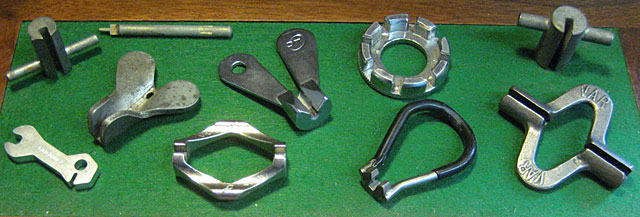
A
selection of spoke wrenches. There are many more you might find.
The black wrench is Park’s SW-0, which fits many standard
road wheels. They also make a
red, green and blue model for different size nipples, plus
an adjustable/locking
model for those hard-to-turn rounded nipples. On the lower
left is one for Shimano Dura-Ace wheels. The cylindrical one on
the top left is for placing nipples in deep-dish wheels so you
don’t drop the nipple inside the rim and have to shake it
out—always a pain.
A
lot of people will tell you that the round, multi-size wrench
is a wheel-wrecker, but that’s only if you don’t understand
how to use it. It’s actually super handy since with one
wrench you can true almost any wheel with standard nipples. You
just have to be careful to select the right slot with each spoke
adjustment. But, that’s easy once you get the hang of it.
Not
shown are the many unique spoke wrenches for the custom nipples
often found on modern aero wheels. If you ride these, the wrenches
are often provided with the wheels. If not, it’s a good
idea to buy one and keep it in your seat bag. Even if you can’t
true the wheel, if you at least have the wrench, someone might
be able to help you on the road. I will.
|
 While
you can flip a wheel around in your fork or frame to determine if
the rim is centered over the locknuts (or do it in your truing stand),
a more accurate way is to use a tool that lets you measure one side
and compare it to the other. That tool is called a dishing gauge.
Shown is the Park
Wheel Alignment Gauge. It can be used while the wheel is in
the truing stand too, a nice time-saver.
While
you can flip a wheel around in your fork or frame to determine if
the rim is centered over the locknuts (or do it in your truing stand),
a more accurate way is to use a tool that lets you measure one side
and compare it to the other. That tool is called a dishing gauge.
Shown is the Park
Wheel Alignment Gauge. It can be used while the wheel is in
the truing stand too, a nice time-saver. |
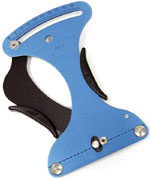 Park’s
Spoke
Tension Meter puts a number on spoke tension and that’s
important for finding the optimum tension for your rim, hub and
spoke combination. It also lets you balance the tension to ensure
you build the strongest wheel.
Park’s
Spoke
Tension Meter puts a number on spoke tension and that’s
important for finding the optimum tension for your rim, hub and
spoke combination. It also lets you balance the tension to ensure
you build the strongest wheel. |
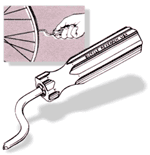 The
Bicycle
Research Nipple Driver is a faster and more fun way to install
nipples when lacing wheels. You can also use an electric drill,
however there’s something nice about this elegant, light,
portable tool and it’s just about as fast as the drill in
the hands of a pro. It’s also much less likely to overtighten
the way a drill could.
The
Bicycle
Research Nipple Driver is a faster and more fun way to install
nipples when lacing wheels. You can also use an electric drill,
however there’s something nice about this elegant, light,
portable tool and it’s just about as fast as the drill in
the hands of a pro. It’s also much less likely to overtighten
the way a drill could. |

to the WRENCH page
|







